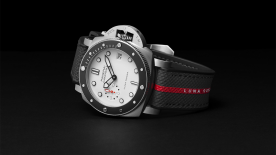He who laughs last laughs longest. At least, until now, it’s the watchmakers with the records who have always had the last laugh. The past five years have seen some epic battles between companies focused on breaking records in two specific areas. The quest for lightness has opened up the market for tools and materials never seen before, and the increasing slenderness of cases has pushed their robustness to the absolute limit. The very idea of records has been taken to almost ludicrous extremes, with the claims of newly launched models relying on improvements of mere hundredths of a millimetre. These rather unnecessary microscopic advances seem to be tailing off and, like all improvements in watchmaking, lightness and thinness are becoming more widespread. They are also rapidly coming down in price.
Under pressure from a market that is losing patience with senseless boasts and growing more open to reason, the trend appears to be declining, although it nevertheless looks likely to go out with a bang. The Octo Finissimo Minute Repeater by Bulgari, which was released in 2016, demonstrates the company’s extraordinary accomplishments in the development of striking watches. Its movement is just 3.12 mm thick, and the case in which it is housed measures a mere 6.85 mm, 1.25 mm thinner than the previous record-holder, made by Vacheron Constantin. Bulgari also holds the record for the slimmest tourbillon watch, which measures just 5 mm in its Octo case.

The record for the thinnest mechanical watch was at one time held by Piaget’s Altiplano 900P, which mobilised some unusual, if not completely unheard-of, construction techniques. With its 3.65 depth, the mainplate was built into the case back, eliminating one of the essential layers that make up the watch. Jaeger-LeCoultre, historically another accomplished specialist in ultra-slim watches, responded in time-honoured fashion by shaving a few microns off its own candidate for the record. Its Master Ultra Thin Squelette measures just 3.6 thick, and didn’t have to resort to any particularly inventive means of achieving this.

Is it possible to go any further? Beyond the achievement itself, which is often perfectly laudable, the advantages of greater slimness on the wrist are far from obvious. Indeed, the effect created by a 6 mm case that is slim around the edges, widening in the centre to nestle comfortably between the wrist bones, is equally attractive. And let us not forget that Montblanc broke the record in 2015 with its Heritage Chronométrie Ultra Slim, which boasts a 5.8 mm case at the entirely reasonable price of €1,965. Each tenth of a millimetre gained beyond this is likely to be costly. Very costly.

In terms of lightness, Richard Mille was quick to throw down the gauntlet, in the shape of the RM27-01. Thanks to a composite case made of high-quality plastic and a skeleton movement suspended on cables to replace the mainplate, it weighs less than 30 grams. The record has proved tenacious, and still stands today. Nevertheless, many advances have been made, thanks to the widespread use of carbon-based composite materials. Richard Mille took the experiment further with his RM35-01. We don’t know the total weight, but we do know the movement weighs 4 grams.

Others have comfortably bettered the 50-gram mark, which is already extremely light, but they have done so at increasingly inaccessible prices. Rado offers a Hyperchrome Ultralight in silicon nitride, a ceramic, which weighs a total of 56 grams, for a cost of €3,000. But what we’re all really looking forward to seeing is a carbon watch with titanium movement at under €2,000. Who’s up for a challenge?









